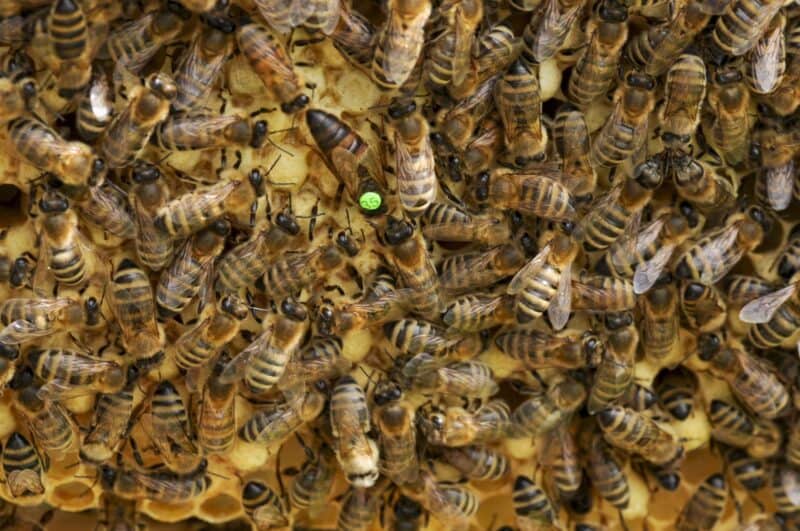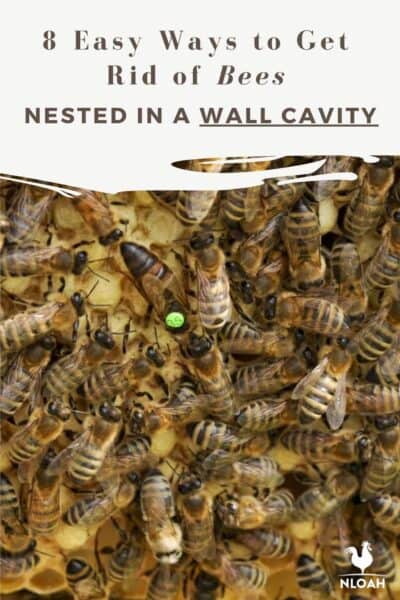Bees are among the most industrious insects on Earth. We should be thankful for these hard-working pollinators, because without them, so many crops that we depend on would basically fail entirely.

However, as necessary as they are, bees can also be big pests, particularly when they decide to set up a thriving hive inside the cozy walls of our home!
No matter how much you like and care about the bees, you can’t let this situation go on. It increases the chances of people and pets getting stung and it can start to actually degrade the structure of your home.
They’ve got to go, and to help you get rid of them I’ll tell you about the ways to get them out of your walls, and you might not even need to hurt them.
Grab your bee suit for safety and let’s get going…
How Can You Tell Bees Are in Your Walls?
It’s pretty easy to tell if you’ve got bees inside your walls. If you notice a lot of bees coming and going from the same side of your house when you’re outside, start paying close attention.
If you see them entering and exiting a specific point, it is all but certain they’ve already established a hive in there.
If you’re still unsure, make your house quiet and then listen carefully in every room and in every closet. Listen for a droning buzz that is continuous; that’s them!
You can also look for mysterious stains appearing on walls or ceilings (bee poop and wax staining), soft and spongy drywall, and areas on a given wall that are curiously very warm to the touch (bees generate a lot of heat!).
All reliable indicators of bee infestation! Try the following to get rid of them…
Seal Up Your Home
The very best way to get bees out of your walls is to keep them from setting up shop in your walls in the first place. I mean to say you should make it a point to seal up your home by no later than early spring.
Go around your house on the outside and look for any crack, any crevice, any slipped joint, whole or opening that could allow bees to access the interior spaces of your home.
This could be cracks in masonry, dislodged, siding, loose soffits, split shingles, sagging trim, missing flashing- anything that could allow bees to enter a space that is warm, dry, and protected from predators.
That’s all they’re looking for when they are nesting. So, grab yourself a caulking gun with some all-weather caulk, expanding gap-filling foam, weatherproof tape, hardware cloth, and whatever else you need to tidy up and tune up your place.
Stop at nothing, and pay special attention to chimneys and openings around vent and pipe stacks. A bee can wriggle through a tiny opening, so be diligent and do a thorough job. If you do this right, you won’t need any of the other techniques on this list!
Call a Beekeeper!
Take it from me, sometimes discretion is the better part of valor. This is a job that’s often best left to the professionals.
Not only do you want to avoid damaging your home, but it would be best if you would avoid pissing off a hive swarming with bees that will then pour out in retaliation to sting the daylights out of you.
Sure, it sounds funny, but once you start getting around 20 stings, or more, you’re dealing with a medically significant event.
So naturally, you should call a beekeeper. A beekeeper, not an exterminator. A beekeeper will have the tools, training, and know-how to easily locate the bees and probably remove them from your home with a minimum of fuss and damage.
Even better, they’ll be more than happy to rehome the hive on their own farm, giving the bees another chance at life and allowing them to go about their important work in the ecosystem.
Best of all, most beekeepers are usually able to provide this service free of charge or for a greatly reduced cost because they can snag a mature and thriving hive basically for free.
Use Repellents
Believe it or not, it is possible to use all-natural or commercially available be repellents to potentially drive bees away from their hiding place inside your walls.
There are lots of things that bees despise, including herbs like basil and rosemary, along with spices like cinnamon, vegetables like cucumbers, and even some oddball things like baby powder.
Sound too good to be true? I promise it’s not, and this is a great way to get rid of bees without using any toxic poisons and without directly harming them.
Whether you’re using something all-natural or a commercially available bee repellent, you want to scatter it all around the entrance that they use to get into your home and back to their hive.
If possible, try to get some directly inside the hole, but you want to do this at night and do so carefully so you don’t get stung.
With a little luck, it will agitate the bees enough that they give up and vacate. However, for a large and thriving hive, it’s unlikely to completely displace them.
Smoke Them Out
If a repellent isn’t working, you might consider smoking out the bees using a bee smoker, or an improvised solution like a portable fire pit or wood smoker.
This can be tricky to do if you don’t have the bee smoker because the wind needs to be on your side, and you also need to be extremely careful that you don’t accidentally set your house on fire if you’re using any other sort of appliance.
Beekeepers use smoke to keep their bees calm, but prolonged exposure to smoke will become an irritant to them because it will disrupt the pheromone signals that the hive uses to maintain order.
If the wind is in your favor, a prolonged smoke session might get the bees to give up their hive and head for greener, cleaner pastures.
The obvious drawback is that this is a method that requires full and total attention for the duration and it can take quite a long time, to say nothing of the fuel you’ll need to pull this off.
That being said, the pervasive nature of smoke makes this more effective than using the other repellents above most of the time.
Try an Ultrasonic Bee Deterrent
A controversial method of getting rid of bees, some folks swear by them, while others decry them as a total scam.
All I know is that there are a few folks out there who swear up and down these things are legit, the bee’s knees you might say. Sorry, couldn’t help myself.
Anyway, in theory, it makes sense: bees are incredibly sensitive to vibration, and these emitters produce ultrasonic sound waves that the insects can perceive, and that might be enough to agitate them and force them to leave.
Again, the theory is sound because if bees grow too stressed a hive might attempt to relocate. In practice, it doesn’t get any easier than this…
You could buy a few of these emitters and place them near the entrance hole that the bees are using to get into your home, and maybe even one on the opposite side of the wall after you’ve located them from inside your home.
Hopefully, you can turn these things on and leave them running and then in a few days the bees will be history.
Place Bee Traps
If you’re done messing around trying to vacate the bees or to relocate them without harming them, and your attempts haven’t met with any success, it is time to go lethal.
There are all sorts of insect traps on the market, including ones that are bee specific, and many more that you can make yourself.
Most of these traps work by attracting the bees with colors and fragrances that they associate with food, and then once they enter the trap, they’re either killed by poison or water, or else they cannot get back out again, and then they subsequently starve.
This is certainly an effective way to get rid of bees without spraying indiscriminate poisons around, but they take time because you must fully depopulate the hive for it to collapse.
If you already have a large and thriving hive in your walls, you’ll need quite a few traps set up along their route and you’ll need to give them time to work.
But slowly, surely, the hive will begin to lose its population and then eventually collapse if the queen does not flee.
Apply Pesticide
If you really just want the bees gone and don’t care about the consequences for the ecosystem you can resort to pesticides to kill them directly, quickly, and certainly.
There are countless kinds of pesticides on the market, once again including types that are bee-specific. You can use liquids, powders, aerosols, foggers, and a lot more to get the job done, or a combination of all of them.
However, you want to be very cautious if you’re doing this yourself because you will necessarily have to get close enough to the hive entrance for the bees to register you as a threat.
Also, consider that you are pumping this stuff into your walls, and depending on where the hive is situated, you may or may not be able to reach it directly.
Instead, you’ll only begin to kill off bees that cross the area where the poison was applied when coming and going. This will usually necessitate several applications over time for a complete kill.
But if you’re lucky, it might be possible to deploy a fogger inside the hive entrance that will completely permeate the hive and kill the queen, young and all.
As I mentioned in the repellent application above, this is something you’ll want to do at night and as quickly and cautiously as you can while the bees are all inside resting.
Try this during the daytime at your own peril! If you’re going to go that route, I would recommend a full bee suit.
Call the Exterminator
As I alluded to above regarding calling a beekeeper, some jobs are truly better left to the professionals. If you don’t care about saving and relocating the bees, an exterminator will definitely know the best approach for eliminating that hive in your walls.
Unlike a beekeeper, he’ll typically be able to do it in a minimally invasive way, i.e. they won’t have to cut off a huge section of your drywall or cladding to get at the hive.
An exterminator might use several methods to depopulate the hive, such as deliberately aggravating them so they deploy in defense only to get sucked into a vacuum cleaner, then apply of heavy-duty pesticides in strategic places that will kill the bees dead, dead, dead.
I’ve seen several exterminators surgically take out a hive in a wall by drilling tiny holes from inside the home that could route poison directly into the hive itself with maximum effect. Special nozzles and covers prevent bees from flying back out through the holes while the poison does its deadly work.
It would be better if the bees didn’t have to die… but the safety of you and your family should come first. If you know the problem is already out of control and you don’t have time to mess with a beekeeper, don’t hesitate to call an exterminator.

Tom has lived and worked on farms and homesteads from the Carolinas to Kentucky and beyond. He is passionate about helping people prepare for tough times by embracing lifestyles of self-sufficiency.
